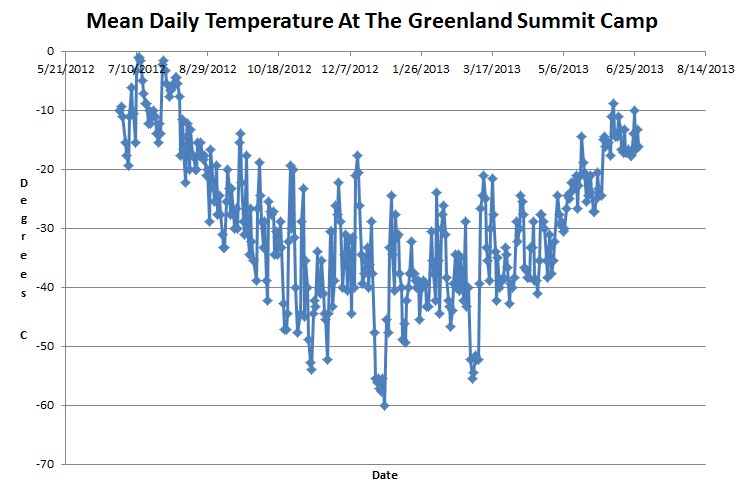July 24, 2012
Satellites See Unprecedented Greenland Ice Sheet Surface Melt
WASHINGTON — For several days this month, Greenland’s surface ice cover melted over a larger area than at any time in more than 30 years of satellite observations. Nearly the entire ice cover of Greenland, from its thin, low-lying coastal edges to its 2-mile-thick center, experienced some degree of melting at its surface, according to measurements from three independent satellites analyzed by NASA and university scientists.On average in the summer, about half of the surface of Greenland’s ice sheet naturally melts. At high elevations, most of that melt water quickly refreezes in place. Near the coast, some of the melt water is retained by the ice sheet and the rest is lost to the ocean. But this year the extent of ice melting at or near the surface jumped dramatically. According to satellite data, an estimated 97 percent of the ice sheet surface thawed at some point in mid-July.
NASA – Satellites See Unprecedented Greenland Ice Sheet Surface Melt
According to NASA, 47% of the ice sheet melted unnaturally last summer. There is only one weather station on the ice sheet, and it had no days last summer which averaged above freezing.
At the bottom of the article, NASA casually mentioned that whatever they claimed was unnaturally happening, actually occurs about once every 150 years.
“Ice cores from Summit show that melting events of this type occur about once every 150 years on average. With the last one happening in 1889, this event is right on time,” says Lora Koenig, a Goddard glaciologist and a member of the research team analyzing the satellite data.



It appears that at this late date that Summit has not risen about 16 F degrees. It looks like no huge ice melt during this summer.
the heat is hiding in the ice and when it comes out….
And I still don’t see how something that happens every 150 years can be right on time if the last time it happened was 123 years ago.
The Greenland DYE-3 ice core shows melting events in [roughly]: 1960, 1885 and 1820.
So looks more like “once every 64 years on average” [with 2012 included].
http://malagabay.wordpress.com/2013/06/27/chronology-2-greenland-and-oxygen-isotopes/
Similar to Wolf-Gleissberg solar cycles … really interesting. The Arctic (and Greenland) and the AMO seem very sensitive to solar cycles (with a lag of few years)
How thick was Greenland’s currently 2-mile thick ice at the height of the last ice age 20,000 years ago?
The weight release of the ice receding since then has caused rebound in the Earth’s crust centered there, and subsidence in the crust further away (centered on mid-Atlantic coast, hence the varying sea level rise there). That’s why the Atlantic coast sea level rises but varies on different locations, depending on distance to Greenland.
The Pacific has no Greenland equivalent and its sea level has been consistent. Perhaps El Niño affects things there?
Ice evaporates too, in low humidity and high wind situations. Doesn’t have to melt first. Irrelevant to temperature alone, ice ebbs and flows with humidity and winds.
My opinion anyway.
The graph shows that Greenland is considerably colder in 2013 (~ 10 C on mean average) than last year. I agreement with the recently observed record coldest start of summer in the Arctic
http://iceagenow.info/2013/06/coldest-start-arctic-summer-record/
How good it feels when you can actually look at the data and see that it makes sense and there is a sound, logical, scientific explanation behind it.